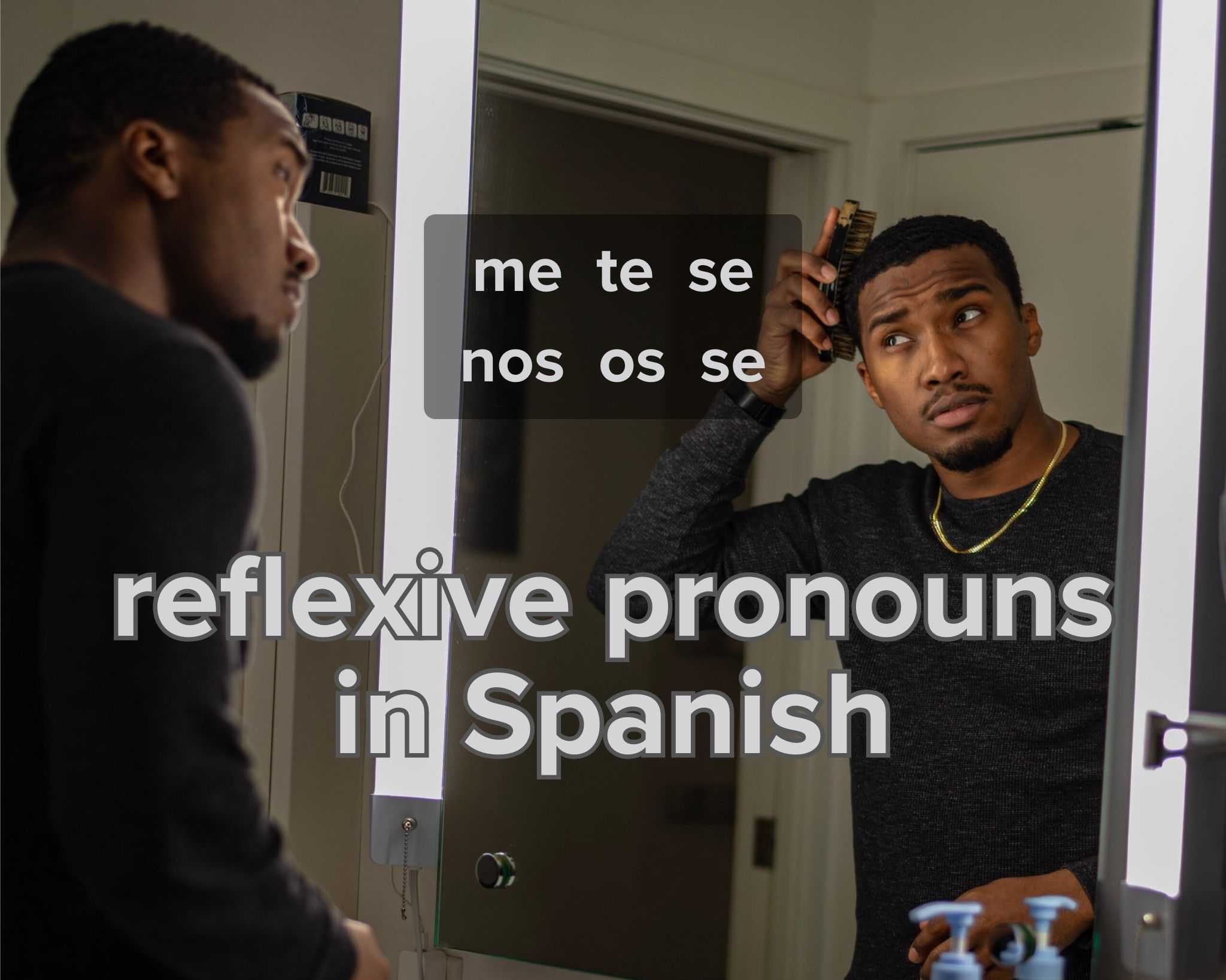Reflexive Pronouns in Spanish: An easy guide

Get our free email course, Shortcut to Conversational.
Have conversations faster, understand people when they speak fast, and other tested tips to learn faster.
More infoReflexive pronouns in Spanish are used in a variety of grammatical contexts. The most common use of reflexive pronouns in Spanish is when the subject and direct object of a verb are the same, but there are several other sentence structures where we utilize the Spanish reflexive pronouns.
In today’s post we’ll cover everything you need to know about the reflexive pronouns Spanish uses. We’ll start by defining what reflexive pronouns are, comparing them with their corresponding subject pronouns in Spanish and reflexive pronouns in English. Like we do in all our posts, we’ll include a ton of examples to show how to use reflexive pronouns in Spanish.
In the second half of the post, we’ll take a look at word order when we use Spanish reflexive pronouns. In addition to standard declarative sentences, we’ll look at three other common sentence structures. We’ll also make sure to compare Spanish reflexive pronouns with object pronouns, since many of these are identical. We’ll end our lesson with some exercises to give you a bit of Spanish reflexive pronoun practice.
You may want to start with this video where, in under five minutes, Mafalda gives an overview of the reflexive pronouns in Spanish: what they are and where to place them in a sentence. For a more in-depth lesson with lots of examples to show the reflexive pronouns in action, read on!
What are reflexive pronouns?
In simple terms, we use reflexive pronouns and verbs when referring to actions that we perform on ourselves. Likewise, the same rule can be applied to actions that other people perform on themselves. A few examples of reflexive pronouns in English are myself, yourself, or themself.
The most basic use of reflexive pronouns in Spanish for describing one’s daily routine.
- Yo me despierto. – I wake [myself] up.
- Tú te bañas. – You bathe [yourself].
- Él se viste. – He gets [himself] dressed.
Since reflexive pronouns (myself, yourself, etc) are used less often in English, the direct translation often sounds a bit clumsy.
Another reason to quickly master reflexive pronouns and verbs is to help make your conversation sound more fluent by enabling shorter sentences.
For example, you could use an indirect object pronoun to say:
- Yo compré una camisa para mí. – I bought a shirt for me.
Or you could use a reflexive pronoun to sound less robotic and more like a native speaker:
- Yo me compré una camisa. – I bought myself a shirt.
Let’s take a look at a few more examples before we move on to our list of reflexive pronouns in Spanish:
- Me baño todos los días. – I bathe [myself] every day.
- Te miras al espejo. – You look at yourself in the mirror.
- Mi madre se prepara el desayuno. – My mother is preparing herself breakfast.
For the rest of this post we’ll focus on reflexive pronouns. We’ll include links to other detailed posts where relevant, such as our lesson on reflexive verbs.
What are the 5 reflexive pronouns in Spanish?
There are just five reflexive pronouns in Spanish: me, te, se, nos, os.
The third-person reflexive pronoun se is used to refer to both singular and plural subjects, so it corresponds to the subject pronouns él, ella, usted, ellos, ellas, and ustedes.
Here’s the full list of reflexive pronouns in Spanish. We list them in order with their corresponding subject pronouns in Spanish. We also include the equivalent reflexive pronouns in English. See our other posts if you need a refresher on the Spanish subject pronouns, on the difference between Tú and Usted, or on all the forms of You in Spanish.
| Subject pronouns, Spanish | Reflexive pronouns, Spanish | Reflexive pronouns, English |
| yo | me | myself |
| tú | te | yourself |
| él, ella | se | himself, herself, itself, themself |
| usted | se | yourself |
| nosotros, nosotras | nos | ourselves |
| vosotros, vosotras | os | yourselves |
| ellos, ellas | se | themselves |
| ustedes | se | yourselves |
Note that se can sometimes be used as a third-person indirect object pronoun. In most cases, however, the third-person indirect object pronouns are le and les. We explain the context where they become se in our post on Spanish indirect object pronouns, and also touch on it near the end of this post.
We also have a comprehensive post explaining all the uses of se in Spanish, including its various other roles as a reflexive pronoun. Today’s post just covers uses that apply to all reflexive pronouns in Spanish. Check out that post for additional uses that apply only to the reflexive pronoun se, such as for constructing the passive voice or saying each other in Spanish.
Now let’s review some examples using every reflexive pronoun. We’re including natural-sounding English translations here, so many of them don’t include English reflexive pronouns.
- Yo me siento en la silla. – I sit on the chair.
- Tú te lavas el cabello dos veces por semana. – You wash your hair twice a week.
- Él se mira en el espejo. – He looks in the mirror.
- Ella se cepilla los dientes. – She brushes her teeth.
- Alguien saltó la valla y se subió hasta la ventana. – Someone jumped the fence and lifted themself up to the window.
- Usted se despierta temprano cada día. – You wake up early every day.
- Nosotros nos quitamos los zapatos. – We take off our shoes.
- Nosotras nos lavamos las manos. – We wash our hands.
- Vosotros os servís el postre. – You serve yourselves dessert.
- Vosotras os compráis vestidos de damas de honor. – You buy yourselves bridesmaid’s dresses.
- Ellos se acuerdan de su primer beso. – They remember their first kiss.
- Ellas se quedaron en la escuela con las otras niñas. – They stayed at school with the other girls.
- Ustedes se llevan el coche para recoger a los niños. – You take the car to pick up the children.
Note that we’ve included the subject pronouns (yo, tú, él, etc) in these sentences to demonstrate today’s lesson, since we want to show that the reflexive pronouns need to match the grammatical person of the subject. However, including the subject pronouns is often completely optional. These two sentences mean exactly the same thing, for example:
- Ellas se lavan las manos. – Se lavan las manos. – They wash their hands.
We explain this in more detail in our post on how and when to use the Spanish subject pronouns.
How do you use reflexive pronouns?
Up to this point, we’ve just seen the Spanish reflexive pronouns placed before a conjugated verb in declarative sentences. This is the most common sentence structure.
- Ella se mira en el espejo. – She looks at herself in the mirror.
Now let’s look at three other ways to use reflexive pronouns, and how they’re placed in different Spanish sentence structures.
1. Verbs in the infinite form
A lot of sentences in Spanish contain conjugated verbs that work alongside verbs in their infinitive form in a construction called a verbal periphrasis. When our verbal periphrasis includes an infinitive verb like this, we have two options for where to place our reflexive pronoun.
The most common option is for the reflexive pronouns to be placed directly onto the end of an infinitive verb:
- Tengo que bañarme. – I have to bathe myself.
The reflexive pronoun can also be placed before the conjugated verb that works with that infinitive:
- Me tengo que bañar. – I have to bathe myself.
In both examples, the meaning is exactly the same.
Let’s take a look at a few more examples of the same concept:
- Ellas tienen que lavarse las manos. – Se tienen que lavar las manos. – They have to wash their hands.
- Él quiere dormirse temprano. – Él se quiere dormir temprano. – He wants to go to sleep early.
- Vamos a lavarnos la cara. – Nos vamos a lavar la cara. – We are going to wash our faces.
2. Progressive verbs
The present progressive structure in Spanish is equivalent to your use of ‑ing verbs in English. While the structure in English calls for a conjugated form of to be followed by the ‑ing form of the action verb, the structure in Spanish generally starts with a conjugated form of estar followed by the Spanish gerund.
So when we use the progressive structure, where do reflexive pronouns go in Spanish? Well, since this is another form of verbal periphrasis in Spanish, we have the same two options that we saw above: it’s either attached to the end of the gerund, or it’s placed before the conjugated progressive verb.
Once again, both options will result in the same meaning. Here are our examples showing the progressive verbs with reflexive pronouns in Spanish.
- Estoy bañándome. – Me estoy bañando – I am bathing myself.
- Ellas están lavándose las manos. – Ellas se están lavando las manos. – They are washing their hands.
- Él está durmiéndose temprano. – Él se está durmiendo temprano. – He is going to sleep early.
- Estamos lavándonos la cara. – Nos estamos lavando la cara. – We are washing our faces.
In case you’re wondering why the first instances of the gerunds in these examples have added accents, it’s to keep the emphasis on the same syllable when we pronounce the word. We explain this phenomenon in our post on syllables in Spanish. The same thing happens in the imperative, as you may notice below.
3. The imperative mood: Spanish commands
When we give orders to other people, we use the imperative. Spanish uses specific verb conjugations depending on whether the commands are in the affirmative or the negative. When our commands include reflexive pronouns, their placement differs between these two cases.
When we give orders in the affirmative, the reflexive pronouns will always be attached to the end of the conjugated verb. Let’s see some examples.
- Lávense las manos, chicas. – Wash your hands, girls.
- Duérmete temprano, mi hijo. – Go to sleep early, my son.
- Ponte los zapatos y vamos. – Put on your shoes and let’s go.
When we give orders in the negative, our Spanish reflexive pronouns go right after the negation word no. Let’s take a look at some examples.
- No te bañes ahora, tenemos que irnos. – Don’t bathe now, we have to get going.
- No se laven las manos. – Don’t wash your hands.
- No te duermas temprano. – Don’t go to sleep early.
- No se laven la cara. – Don’t wash your faces.
Keep in mind that we can only give orders to other people, so there’s no imperative form for ordering oneself in the first person. If you see the Spanish pronoun me in a Spanish command, it can’t be a reflexive: it’s probably an indirect object pronoun meaning to me or at me.
- ¡Mírame! – Look at me!
This brings us to the last common misconception we need to clear up before we finish.
Spanish reflexive pronouns vs Object pronouns
It’s very common to confuse reflexive pronouns with object pronouns, since many of these pronouns are the same. In fact, four of them are identical to their corresponding direct and indirect object pronouns: me, te, nos, os.
To see where these pronouns differ in Spanish, here are all the Spanish personal pronouns.
| Subject pronouns | Direct object pronouns | Indirect object pronouns | Reflexive pronouns |
| yo | me | me | me |
| tú | te | te | te |
| él, ella, usted | lo, la | le (se) | se |
| nosotros, nosotras | nos | nos | nos |
| vosotros, vosotras | os | os | os |
| ellos, ellas, ustedes | los, las | les (se) | se |
When comparing direct vs indirect vs reflexive pronouns, you’ll notice that only the third-person pronouns differ between the three. Let’s review them side-by-side to clear up any confusion.
In simple terms, we use reflexive pronouns when the subject is the recipient of the verb’s action.
- Él se compra una camiseta. – He buys himself a shirt.
- Él se la compra. – He buys it for himself.
In this pair of example sentences, se is the third-person reflexive pronoun referring to himself. In the second sentence, la is the direct object pronoun replacing una camiseta.
When one subject applies an action to someone or something else, we use object pronouns rather than reflexive pronouns. Since most of the reflexive and object pronouns are the same, we only really use different words when we have a third-person indirect object like him, her, it, or them.
- Él le compra una camiseta a ella. – He buys her a shirt.
- Él se la compra a ella. – He buys it for her.
In this second pair of example sentences, le is the indirect object pronoun referring to her. In the second sentence, la is the direct object pronoun replacing una camiseta; in this case, the indirect object pronoun le has transformed to se to avoid the awkward pronunciation of le la. Placing two object pronouns together like this is the only context where we use se as an indirect object pronoun.
We’re getting into advanced territory here, so if you want to learn more about the intricacies of object pronouns we’ll recommend you check out our dedicated posts on direct object pronouns and indirect object pronouns.
We also highly recommend our big overview post on Se in Spanish. There we cover the phenomenon of the indirect object se that we’ve just seen, along with all the other uses of the reflexive pronoun se that we didn’t cover in today’s post.
Conclusion: Reflexive pronouns in Spanish
This post provided an easy guide to the reflexive pronouns Spanish speakers use on an everyday basis. Let’s do a quick recap before we go.
We started off by answering the question of what are reflexive pronouns in Spanish, learning that the English versions usually end in -self or -selves. We saw that the five reflexive pronouns in Spanish are: me, te, se, nos, os. Se is the reflexive version for all the third-person pronouns in Spanish, including él, ella, usted, ellos, ellas, and ustedes.
Once we’d seen all reflexive pronouns, Spanish sentence structure came next. We saw that the reflexive pronouns are usually placed directly before the conjugated verb, but that certain constructions allow their placement elsewhere in the sentence.
We concluded with a comparison of reflexive pronouns vs object pronouns, since many of them are identical between these grammatical categories. We gave a quick overview of how to tell them apart, while referring you to our other posts that go into a lot more detail.
By now, can you explain what are the reflexive pronouns in Spanish? We hope so! We’ll leave you with a few practice exercises to see if you’ve learned them all.
Practice: Reflexive pronouns in Spanish
Now it’s time to test how well you’ve learned the reflexive pronouns in Spanish. Simply add the correct Spanish reflexive pronouns to the sentences below. Remember that you can look to the subject pronouns to know which reflexive pronouns you need to use! Scroll to the bottom for the answers.
1. Cuando ___ despierto, yo ___ lavo los dientes. – When I wake up, I brush my teeth.
2. Ella ___ peina su cabello antes de ir a la escuela. – She combs her hair before going to school.
3. ___ vestimos para salir a bailar esta noche. – We get dressed to go dancing tonight.
4. Yo ___ quito el maquillaje antes de ir a dormir. – I take off my makeup before going to sleep.
5. Vosotros no podéis perder___ ningún ensayo. – You can’t miss any rehearsal.
6. Tú barba está muy larga, ¡Afeita___! – Your beard is too long, please shave!
7. Él está poniéndo___ los zapatos. – He’s putting on his shoes.
8. ___ relaja oír música suave. – It relaxes me to hear soft music.
9. Cuando voy a la playa, ___ baño en el mar durante muchas horas. – When I go to the beach, I bathe in the sea for many hours.
10. ___ rompí la pierna cuando ___ caí patinando. – I broke my leg when I fell skating.
Answers
1. Cuando me despierto, yo me lavo los dientes.
2. Ella se peina su cabello antes de ir a la escuela.
3. Nos vestimos para salir a bailar esta noche.
4. Yo me quito el maquillaje antes de ir a dormir.
5. Vosotros no podéis perderos ningún ensayo.
6. Tú barba está muy larga, ¡Afeitate!
7. Él está poniéndose lo zapatos.
8. Me relaja oír música suave.
9. Cuando voy a la playa, me baño en el mar durante muchas horas.
10. Me rompí la pierna cuando me caí patinando.



